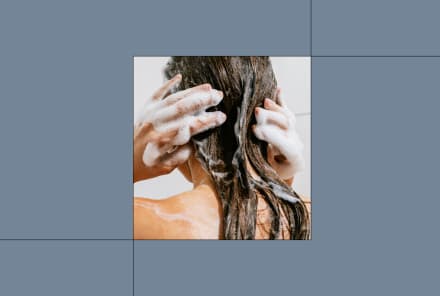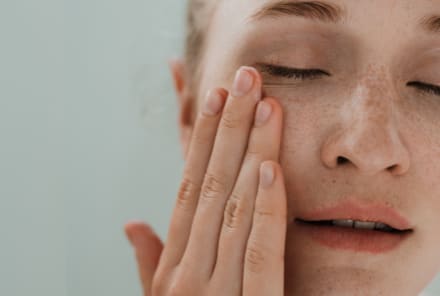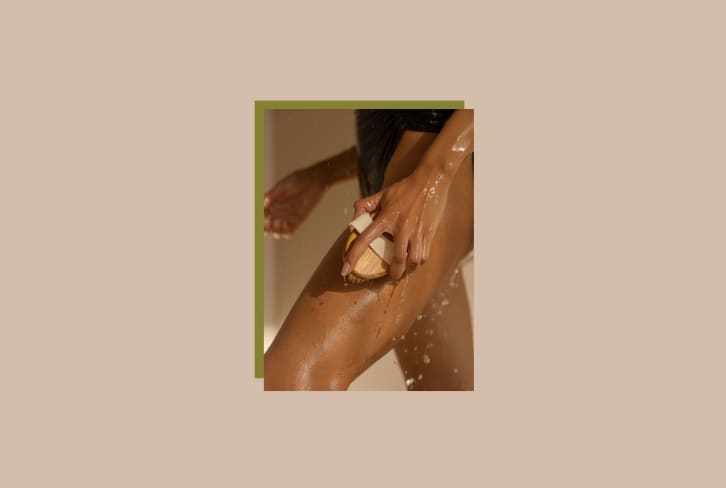Advertisement
Everything You Need To Know About Treating + Preventing Dry, Cracked Feet

Hannah Frye is the Assistant Beauty Editor at mindbodygreen. She has a B.S. in journalism and a minor in women’s, gender, and queer studies from California Polytechnic State University, San Luis Obispo. Hannah has written across lifestyle sections including health, wellness, sustainability, personal development, and more.
Whether it's walking to work, taking a long stroll on the beach, or hiking with friends; your feet help you get from point A to point B. While you may not often think to offer gratitude to this part of your body, it's about time you start.
If you neglect adequate foot care, you may be left with excessive dryness, painful cracks, dense calluses, and even peeling skin. If this sounds like something you've experienced before, you've come to the right place. Here, everything you need to know about the causes, prevention, and treatment of dry and cracked feet.
What causes dry feet?
Naturally, the feet have fewer oil glands. This means the area of the body tends to be drier. However, there are other reasons that skin might be noticeably dehydrated and cracked.
It's important to note that there is a wide range of causes for dry feet. Sometimes lifestyle habits are relevant, but other times what's going on inside the body is the primary cause.
A few examples of the latter, according to Brooklyn-based podiatrist Greg E. Cohen DPM, FACFAS, include dehydration, anhydrous (a lack of sweat gland production), diabetes, and aging.
There are lifestyle factors that can lead to dry feet, regardless of what's going on internally, too. Here, a breakdown of the more common reasons that are both internal and external.
Skin conditions
Skin conditions, especially eczema (atopic dermatitis), can mean dry patches on your feet. Eczema is an inflammatory skin condition that causes irritated, itchy rashes on the body and most commonly shows up on areas where the skin folds and moves, such as the hands, face, elbows, back of knees, and heals.
Extra hot showers
Hot water strips the skin of its natural lipids, and therefore can compromise the barrier. Without this critical moisture barrier, skin (including that on your feet) can dry out. In addition, you may want to limit the time spent showering too. "Being mindful of how much time you spend in a bath or shower is another simple solution, as overexposing your skin to water can strip the water from your skin, resulting in more dehydration," board-certified dermatologist Shereene Idriss, M.D. told us about dehydrated skin.
Atmosphere
Your climate may affect your skin health. Notably living in extremely dry and cold places can cause the skin to crack.
Harsh soaps
Soaps and harsh sulfates can lead to barrier disruption. This is especially true for those with naturally dry skin: "If you have sensitive skin, eczema, or a history of any skin disease, please be sure that any body wash you use is sulfate- and artificial-fragrance-free," says board-certified dermatologist Loretta Ciraldo, M.D., FAAD. Look for hydrating formulas buffered with emollients and oils.
Walking barefoot
Walking barefoot isn't necessarily the problem, it's where you're doing it. If you're walking barefoot in places where the skin is being exposed to harsh surfaces it may lead to cracked, dry skin. Another major culprit: walking barefoot in places where the skin can be exposed to fungi and bacteria that can cause infection and irritation, such as gym locker rooms.
Aging skin
As we age, our skin naturally becomes drier thanks to declining levels of ceramides, hyaluronic acid, collagen, and our natural oils. This is totally normal! While there are ways to help slow this process, it's ultimately unavoidable.
Diabetes
According to the American Diabetes Association, diabetes may cause changes in the skin on your feet due to poor blood flow to the area. Speak with your doctor for more information on how to best manage diabetes if this pertains to you.
Vitamin deficiencies
Vitamin deficiencies can affect skin, nail, and hair health. If you have dry skin on your feet it may be a sign of low levels of vitamin C, E, B3, B12, iron and fatty acids1. However, the best way to find out if you are deficient in any nutrient is to consult with your health care practitioner.
Overall dehydration
If your skin and body are dehydrated all over, this can certainly show up on the feet.
Remedies for cracked, dry feet.
If your feet are already cracked, dry, or peeling, you have a few options to treat them. First, pedicures can provide salon-grade exfoliating treatments. Especially if your toenails are dry and brittle, a pedicure is never a bad idea.
On the flip side, if you're one to DIY or if you consistently run into cracked, dry skin on your feet, then creating an at-home routine is definitely worthwhile. Nail expert and co-founder of Brooklyn-based clean nail salon Lili and Cata Lilly Rojas shared some of her favorite at-home remedies with mbg:
Use a foot file.
You can pick one of these tools up at your local drugstore for just a few bucks. The file will help exfoliate the driest patches on your feet, especially if you're prone to stubborn calluses.
Opt for a pumice stone.
If your feet are on the sensitive side, or you're experiencing minor dryness, then a pumice stone might be a better choice. These tools are a bit gentler than files but still work wonders for sloughing off dead skin.
For the best results, use these tools after the shower, Rojas says. This way, the dead skin on your feet will be softer and thus, easier to remove. Of course, always follow up with a moisturizer (more on that in a second).
Hydration
Arguably the most important step for your skin: hydration. No matter what steps you take before or after, if your skin barrier is compromised, your feet will feel dry and cracked.
Opt for a barrier-supporting body moisturizer for the area. (Sure you can get a special foot or hand cream if you'd like a richer texture, but if you don't want to overpopulate your routine, a body lotion will do just fine.) We recommend finding a well-rounded formula with humectants (like aloe vera and glycerin), emollients (like oat and moringa seed oil), and occlusive ingredients (like shea butter and coconut oil) to adequately moisturize the skin and aid in water retention. Additionally, biome-supporting ingredients and antioxidants can further improve the skin's function.
How to keep your feet hydrated.
Once you've treated your cracked and dry feet, you'll want to get into the habit of keeping them hydrated to prevent a repeat occurrence. A few reminders to keep your feet as soft as can be:
- Moisturize daily: The key to happy feet is daily moisturizing. "Hydrating lotions with shea butter, cocoa butter, coconut oil, or aloe work great," Rojas says. Here, a few of our favorite foot creams if you're on the hunt.
- Exfoliate regularly: If your feet are generally on the dryer side, exfoliating every week or two is a good idea. You can use a foot scrub, the tools mentioned above, or get regular pedicures.
- Be mindful of your habits: Podiatrist Michael Galoyan, DPM, tells mbg that excessive stress to the feet, even if that means walking more often than usual, can lead to dryness as well. If you're frequently on foot, you should be extra mindful of exfoliating and hydrating to keep your feet in the best shape.
- Avoid hot showers: Opting for a lukewarm rinse will certainly help preserve moisture in the feet but benefits your body skin, scalp, and strands too. Extra-hot water can disrupt the skin's microbiome by stripping the skin of natural oils and lipids, so it's best to avoid a steamy cleanse.
Can I use petroleum jelly on my feet?
Many people opt for petroleum jelly to help soothe and hydrate the area overnight. One common tip is to apply the occlusive formula on the feet with socks on top.
Petrolatum, by definition, is a gelled mineral oil, which garners some hot debate: Some deem it unsuitable for some skin types; others say it's totally fine. While mineral oil is petrochemical derived, you can find purified, cosmetic-grade options that are theoretically safe to apply on the skin (as opposed to technical-grade options, which are typically used to lubricate car engines).
However, even cosmetic-grade options are not so environmentally friendly, which is enough of a reason to avoid its use: "Mineral oil is petrochemical derived, meaning it's environmentally irresponsible to use mineral oil when there are vegetable and fruit oils, like coconut oil, that are more sustainable," says clean cosmetic chemist Krupa Koestline about the ingredient. We recommend sticking to more environmentally friendly options, such as responsibly harvested coconut oil, shea butter, and cocoa butter.
FAQ
Why are my feet dry even when I moisturize?
Most often having dry feet is due to the simple fact that people forget to apply a foot cream or hydrator. But if you are one to be diligent with your cream application, but still have dry feet in the area, it may be a sign of something more serious such as a health condition or vitamin deficiencies.
What vitamin deficiencies cause extremely dry feet?
Vitamin deficiencies can affect skin, nail, and hair health. If you have dry skin on your feet it may be a sign of low levels of vitamin C, E, B3, B12, iron and fatty acids. However, the best way to find out if you are deficient in any nutrient is to consult with your health care practitioner.
Is it normal to have dry feet?
Yes, it’s very normal to have dry feet—the skin goes through a lot of wear after all. And there are very normal reasons your feet might be dry and cracked, such as hot showers, forgetting to hydrate, and using harsh soaps. However, there are a few less common reasons that you should be mindful of such as vitamin deficiencies and autoimmune conditions. Speak with your doctor if you have concerns.
The takeaway.
Foot care may not be something you often think about, but it should be, considering your feet help you get to where you want to go every single day. Especially if you're experiencing dry, cracked, or callused skin, it's time for some pedi TLC. Whether internal or external influences cause this dryness, there are plenty of things you can do to treat and prevent dry and cracked skin. A good place to start: this derm-approved DIY foot peel.
Watch Next
Enjoy some of our favorite clips from classes
Enjoy some of our favorite clips from classes
What Is Meditation?
Mindfulness/Spirituality | Light Watkins
Box Breathing
Mindfulness/Spirituality | Gwen Dittmar
What Breathwork Can Address
Mindfulness/Spirituality | Gwen Dittmar
The 8 Limbs of Yoga - What is Asana?
Yoga | Caley Alyssa
Two Standing Postures to Open Up Tight Hips
Yoga | Caley Alyssa
How Plants Can Optimize Athletic Performance
Nutrition | Rich Roll
What to Eat Before a Workout
Nutrition | Rich Roll
How Ayurveda Helps Us Navigate Modern Life
Nutrition | Sahara Rose
Messages About Love & Relationships
Love & Relationships | Esther Perel
Love Languages
Love & Relationships | Esther Perel
-v1646695196476.jpg?1148x800)

















